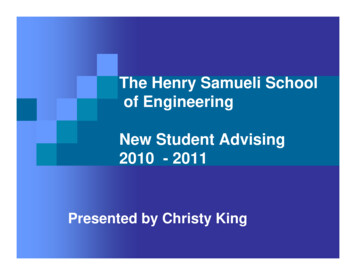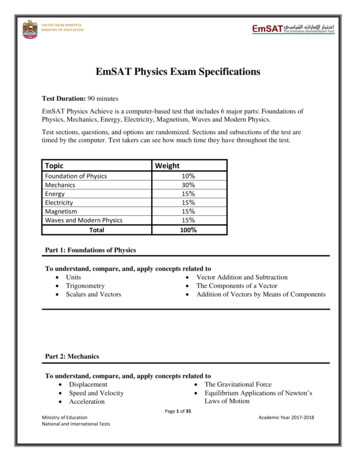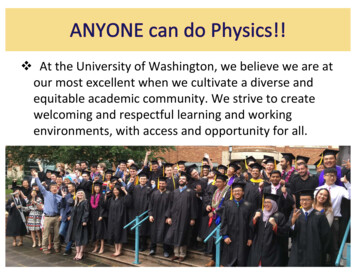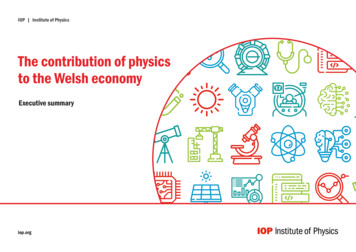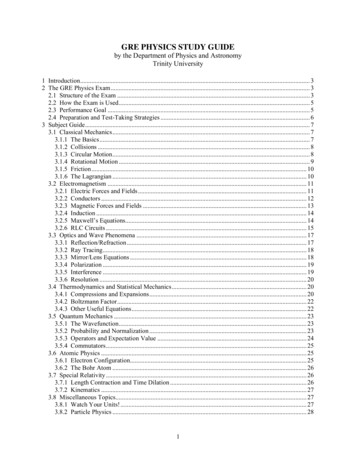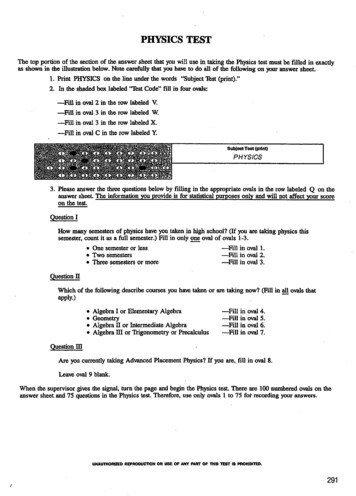
Transcription
PHYSICS TESTThe top portion of the section of the answer sheet that you will use in taking the Physics test must be filled in exactlyas shown in the illustration below. Note carefully that you have to do all of the following on your answer sheet.1. Print PHYSICS on the line under the words "Subject Test (print)."2. In the shaded box labeled 'lest Code" fill in four ovals:—Fill in oval 2 in the row labeled V.—Fill in oval 3 in the row labeled W.—Fill in oval 3 in the row labeled X.—Fill in oval C in the row labeled Y.3. Please answer the three questions below by filling in the appropriate ovals in the row labeled Q on theanswer sheet. The information you provide is for statistical purposes only and will not affect your scoreon the test.Question IHow many semesters of physics have you taken in high school? (If you are taking physics thissemester, count it as a full semester.) Fill in only one oval of ovals 1-3. One semester or less Two semesters Three semesters or more—Fill in oval 1.—Fill in oval 2.—Fill in oval 3.Question IIWhich of the following describe courses you have taken or are taking now? (Fill in all ovals thatapply.) Algebra I or Elementary AlgebraGeometryAlgebra II or Intermediate AlgebraAlgebra E or Trigonometry or lovalovaloval4.5.6.7.Question HIAre you currently taking Advanced Placement Physics? If you are, fill in oval 8.Leave oval 9 blank.When the supervisor gives the signal, turn the page and begin the Physics test. There are 100 numbered ovals on theanswer sheet.and 75 questions in the Physics test. Therefore, use only ovals 1 to 75 for recording your answers.UNAUTHORIZED REPRODUCTION OR USE OF ANY PART OF THfS TEST 18 PROHIBITED.291
PHYSICS TESTPart ADirections: Each set of lettered choices below refers to the numbered questions or statements immediately followingit. Select the one lettered choice that best answers each question or best fits each statement, and then fill in the corresponding oval on the answer sheet A choice may be used once, more than once, or not at all in each set.Questions 1-3 relate to the tronAlpha particle1. Which particle could NOT be deflected by auniform magnetic field?2. If all of the particles were in the same electric field,which would be accelerated in a direction oppositeto the field?3. If all of the particles were in the same uniform electric field, which would have the greatest force actingon it?Questions 4-7 relate to the following equations orphysical principles that might be used to solve certainproblems.(A) Kinematic equations for constant acceleration(B) Newton's second law (F ma)(C) Newton's third law (For every action there is anequal and opposite reaction.)(D) Conservation of mechanical energy(E) Conservation of linear momentumSelect the choice that should be used to provide thebest and most direct solution to each of the followingproblems.4. A marble is dropped from rest at a given heightabove the ground. Air resistance is negligible. Howlong is the marble in free fall?5. A weight is dropped onto the bed of a toy flatcarthat is initially coasting on a straight, horizontal,frictionless track. What is the speed of the flatcarafter the weight has settled on it?6. A frictionless pendulum of given length and massis released from a horizontal position. What is thespeed of the pendulum bob at the lowest positionin its swing?7. A brick of known weight is in free fall. While itis falling, what force does the brick exert on theEarth?3RAC2UNAUTHORIZED REPRODUCTION OR USE OP ANY PART OP THIS TEST IS PROHIBITED.292
PHYSICS TEST—ContinuedQuestions 8-9-RTwo point charges, Q\ and Q2, are separated by a distance Rt asshown above. The following choices refer to the electric force on Q\due to Q2 (A)(B)(C)(D)(E)It is quadrupled.It is doubled.It remains the same.It is halved.It is quartered.8. What happens to the magnitude of the force on Qx if the sign ofQx is changed and Q2 remains the same?9. What happens to the magnitude of the force on QY if Q\ isdoubled and Q2 remains the same?GO ON TO THE NEXT PAGEUNAUTHORIZED REPRODUCTION OR USE OF ANY PART OF THIS TEST 18 PROHIBITED.293
PHYSICS TEST—ContinuedQuestions 10-12 relate to the following graphs(A) y(B) y(D) y(Q y0OO(E) y -XOSelect the graph above that best expresses each of the following relationships (y asa function of x).10. Decay rate of nuclei in a radioactive samplevs.Time11. Kinetic energy of a relativistic particlevs.Speed of the particle12. Maximum kinetic energy of aphotoelectron ejected from a metal platevs.Frequency of the lightincident on the plateGO ON TO THE NEXT PAGEUNAUTHORIZED REPRODUCTION OR USB OF ANY PART OF THIS TEST IS PROHIBITED.294
PHYSICS TEST—ContinuedPartBDirections: Each of the questions or incomplete statements below is followed by five suggested answers or completions. Select the one that is best in each case and then fill in the corresponding oval on the answer sheet13. You are in a glider that is traveling due east at60 kilometers per hour relative to an air mass thatis traveling due north at 60 kilometers per hourrelative to the ground. Your motion relative to theground is(A)(B)(C)(D)(E)Questions 16-17 refer to the electrical circuit shownbelow. Ammeter A reads 2.0 amperes./?, 10 ohms-AAA—idue eastnortheastdue northsouthwestdue south aa/v—iR2- 10 ohmsR3 20 ohms14. Each of the figures below shows the velocity vof a particle and the force or forces acting on theparticle. Forces F and F2 have the same magnitude. In which figure is the particle's speed ordirection NOT being changed?(B)(E)IS. The magnitude of the electric force exerted bycharged particle X on charged particle Y dependson which of the following?I. The magnitude of the charge on particle Xn. The magnitude of the charge on particle Yin. The distance between particle X andparticle Y(A)(B)(C)(D)(E)I onlyIII onlyI and H onlyn and m onlyI, II, and mUNAUTHORIZED REPRODUCTION OR USE OF ANY PART OP THIS TEST IS PROHIBITED.295
PHYSICS TEST—ContinuedQoestions 18-19 refer to the following drawing of a wave.Displacement (m)O.lf 0t18. What is the wavelength of the wave?(A) 0.1 m(B) 0.2 m(C) 0.5 m(D) 1.0 m(E) 2.0 m -Distance (i19. What is the amplitude of the wave?(A)(B)(C)(D)(E)0.1 m0.2 m0.5 m1.0 mIt varies between -0.1 m and 0.1 m.GO ON TO THE NEXT PAGEUNAUTHORIZED REPRODUCTION OR USE OF ANY PART OP THIS TEST 13 PROHIBITED.296
PH SI S ftiST 23. Which of the following is true of the half-life of aparticular radioactive isotope?Questions 20-22(A) It increases as the isotope decays.(B) It increases as pressure increases.(C) It increases as temperature increases.(D) It decreases as the amount of the originalsubstance increases.(E) It remains constant.The sketch above shows the path of a heavy iron ballthrown by an athlete. The ground is level and the dashedlines are parallel to the ground. Assume that tfre fric-tional forces acting on the ball are negligible.20. The speed of the ball at point I, when it leaves thehand of the athlete, is the same as its speed at point(A)n(B)HI(C) IV(D) V(E) VI21. The potential energy of the ball is greatest at point(A) I(B) n(Q in22. Which of the following is a true statement about theacceleration of the ball during its flight?ItItItItItisisisisis(A) Two atoms can have the same atomic numberand different mass numbers.(B) Two atoms can have different atomic numbersand the same mass number.(C) An atom can have an atomic number greaterthan its mass number.(D) A hydrogen atom with one proton and noneutrons is an isotope of hydrogen.(E) The number of neutrons in an atom can beless than the number of protons.23. The fact that heat flows naturally from a hotterbody to a cooler body is a consequence of whichof the following principles of physics?(A)(B)(C)(D)(D)IV(E) VI(A)(B)(C)(D)(E)24. All of the following statements concerning thestructure of atoms are true EXCEPT:Ideal gas lawConservation of chargeConservation of momentumFirst law of thermodynamics (conservation ofenergy)(E) Second law of thermodynamics (entropyincrease)greatest at point I.greatest at point III.least at point m.least at point V.the same at all points:UNAUTHORIZED REPRODUCTION OR USE OF ANV0ART OF THIS TEST IS PROHIBITED.297
PHYSICS TEST—Continued26. A black metal ball and a black rubber ball of equalradius are both heated to the same temperature. Aperson who picks up the balls, one in each hand,finds that the metal ball feels hotter to the touch.Which of the following is a correct explanationof this phenomenon?(A) The density of the metal is higher; thereforethe metal ball has a higher heat capacity.(B) The mass of the metal ball is higher; thereforethe thermal energy of the metal ball is higher.(C) The specific heat of the metal is lower; therefore the thermal energy of the metal ball ishigher.(D) The thermal conductivity of the metal is higher,therefore the metal ball conducts heat to thehand more quickly.( ) Hie melting point of the metal is higher; therefore the metal ball can absorb more heatfrom its surroundings.28. Diffraction is a property of which of the following?I. Visible lightn. Sound wavesm. Radio waves(A) I only(B) Ilonly(C) I and II only(D) I and m only(E) I, II, and HI29. Which of the following properties of light can beused to explain why the legs of a child standingwaist deep in water, when viewed from above thewater, appear to be shorter than they actually ePolarizationRefractionGO ON TO THE NEXT PAGE27. In the diagram above, the angle of reflection and therefracted ray are correctly labeled by which of thefollowing?Angle of ReflectionRefracted RayUNAUTHORIZED fiEPfiODUCTION OR USE OF ANY PART OF THIS TEST 18 PROHIBITED.298
PHYSICS TEST—ContinuedQuestions 30-31 refer to the diagram below, whichrepresents a mass suspended on a spring. The massoscillates between levels X and Z. Level Y is halfway between X and Z. Assume that gravitationalpotential energy is zero at Z and that there is no lossof energy from the system due to friction.32. A satellite is moving around the Earth in a circle.All forces on the satellite except the force of gravityare negligible. Which of the following is true of theacceleration resulting from the gravitational force?(A) It is constant in magnitude and direction.(B) It is constant in magnitude but not in direction.(C) It is zero.(D) It causes the speed of the satellite to increase.(E) It causes the speed of the satellite to decrease.ojo!ocfuYZ111J30. The net force acting on the mass is upward and atits greatest magnitude at what level?MX(B)(C)(D)(E)33. A spaceship orbits the Earth at constant speed ina circular path. An astronaut inside the spaceshipreleases a ball, but the ball shows no tendency tomove away from the astronaut's hand. Which of thefollowing best explains the behavior of the ball?(A) Any object moving in a circle around the Earthexperiences no gravitational pull.(B) The gravitational pull of the spaceship on theball exactly balances the gravitational pull ofthe Earth on the ball.(C) The mass of the ball is so small that the pullof gravity exerted on the ball by the Earth isBetween X and YYBetween Y and ZZnegligible.(D) The force of gravity exerted on the ball by theEarth is extremely weak due to the greatdistance of the spaceship from the Earth.31. When the mass is at level X, it has(A) zero energy(B) zero acceleration(E) The force of gravity exerted on the ball by theEarth causes the ball to move in the samecircular path as the spaceship.(C) potential energy but not kinetic energy(D) kinetic energy but not potential energy(E) both potential energy and kinetic energyGO ON TO THE NEXT PAGEUNAUTHORIZED REPRODUCTION OR USE OF ANY PART OP THIS TEST IS PROHIBITED.299
PHYSICS TEST—ContinuedMagnetic Field34. A proton of charge 1.6 x 10 19 coulomb movesthrough a vacuum with a speed v of 1 x 106 metersper second. It passes through a uniform magneticfield as shown above. If the force exerted on theproton is 8 x 10"15 newton, the magnitude of the36. Two wave pulses travel toward the left on a tautstring, as shown above. If the string is tightlyattached to the rigid post at the left, which of thefollowing correctly shows the reflection of thesepulses?(A)magnetic field is most nearly10 27 T10"n T5x 10'10T5x 10'2T(A) 1.3 x2x(B)(C)(D)(E) 20T35. A negatively charged rod is brought close to theknob of an uncharged electroscope and the leavesof the electroscope diverge, as shown above. Thecorrect explanation for this phenomenon is that(A)(B)(C)(D)both leaves become positively chargedboth leaves become negatively chargedboth leaves remain neutralone leaf becomes positively charged and theother becomes negatively charged(E) one leaf becomes positively charged and theother remains neutralGO ON TO THE NEXT PAGEUNAUTHOREEEO REPRODUCTION OR USE OF ANY PART OF THIS TEST IS PROHIBITED.300
PHYSICS TEST—Continued37. A guitar string vibrates with a frequency of400 hertz. If the tension in the string is increasedbut the length of the string is fixed, which of thefollowing will change?40. An object starts from rest and accelerates at 4.0meters per second squared. How far will it travelduring the first 3.0 seconds?(A) 6.0 m(B) 18 mI. The wavelength of the fundamental standing. wave on the stringn. The frequency of the fundamental standingwave on the stringin. The pitch of the sound produced(A)(B)(C)(D)(E)I onlyII onlyI and in onlyII arid m onlyI, n, and m(Q 24 m(D) 36 m(E) 48 mRate(m3/hr)Time (hr)PointSourceScreen 1Screen 238. In a darkened room, monochromatic light from thepoint source shown above passes through two verynarrow slits in screen 1. Which of the followingbest describes the interference pattern that isformed on screen 2 ?(A) A set of bright concentric circles(B) An array of bright dots(C) A continuous bright band dimming toward themiddle(D) A set of bright parallel bars at right angles tothe slits(E) A set of bright parallel bars parallel to the slits41. The graph above shows the rate at which water ispumped into a tank (measured in cubic meters perhour) as a function of time (measured in hours). Theshaded area under the curve is equal to the(A) average volume pumped in one hour(B) average rate of pumping in m3/hr(C) average time required to pump 1 m3(D) total volume of water pumped into the tank(E) total time required to fill the tankGO ON TO THE NEXT PAGE39. If the mass of a body and the net force acting onthe body are both doubled, the acceleration of thebody adrupledUNAUTHORIZED REPRODUCTION OR USE OF ANY PART OF THIS TEST IS PROHIBITED.301
PHYSICS TEST—CtnUbuMdCarACar 5*"Time42. Two cars, A and B, begin moving from astarting line at time f 0 and race over a totaldistance D. The graph above shows their respective distances from the starting line as functions oftime. Correct statements about the cars includewhich of the following?I. At time r,, car A has a greater speed than car B.II. At time th car A is closer to the finish linethan car B.HI. Car A crosses the finish line first.(A)(6)(C)(D)(E)I onlyJJonlyI and HI onlyn and HI onlyI, n, and IIItion each minute. What is its frequency of rotation?(A) 3,600 Hz60 HzlHz1/12 Hz1/60 Hzthe comet is true?(A) The direction of the velocity of the comet andthe direction of the force on the comet arethe same.(B) The speed of the comet is always minimumwhen the comet is closest to the Sun.(C) The speed of the comet is always maximumwhen the comet is farthest from the Earth.(D) The direction and the magnitude of the forceon the comet are always changing.(E) The direction of motion of the comet is alwayschanging, but its speed is constant.45. Which of the following forms of energy is mostlikely to be produced in some amount in nearly allenergy tricalMechanicalSound46. A source emits sound with a frequency of43. The second hand of a clock completes one revolu(B)(C)(D)(E)44. Halley's comet is in an elliptical orbit about theSun and is visible from the Earth once every76 years. Which of the following statements about7.0 x 10 hertz. If the speed of the sound is3.5 x 10 meters per second, what is the wavelength of the sound?(A)(B)(C)(D)(E)4.15.02.02.02.5xxxxx10 7 m10"2 m10"1 m105 m106 mUNAUTHORIZED REPRODUCTION OR USE OF ANY PART OF THIS TEST tS PROHIBITED.302
PHYSICS TEST—Continued47. A plane mirror can be used alone to form a(A)(B)(C)(D)(E)magnified real imagediminished real imagemagnified virtual imagediminished virtual imagevirtual image neither magnified nor diminished49. If electricity costs 0.10 per kilowatt-hour, howmuch does it cost for electricity to operate a 100watt lightbulb for 10 hours?(A) 0,001(B) 0.01(C) 0.10(D) 1.00(E) 10.00Electron Gun48. The figure above shows two pulses on a stringapproaching each other. Which of the followingstatements about the pulses is true?(A) They will reflect off each other, reversing their(B)(C)(D)(E)directions.They will pass through each other withoutchanging their directions.They will completely cancel each other andafterward there will be no pulse on thestring.They will combine to form a single pulse withamplitude twice that of each original pulse.They will combine to form a standing wave onthe string.50. An experiment involves the deflection of an electron beam by a uniform magnetic field as shownabove. In what direction does the magnetic fieldpoint?(A)(B)(C)(D)(E)To the left in the plane of the pageTo the right in the plane of the pageUpward in the plane of the pageInto the pageOut of the pageGO ON TO THE NEXT PAGEUNAUTHORIZED REPRODUCTION OR USE OF ANY PART OF THIS TEST IS PROHIBITED.303
PHYSICS TEST—Continuedpn1.5 m/1.0 m-*-4jxC51. Charges of 4 microcoulombs and -4 microcoulombs are located 1.0 meter apartand fixed in place, as shown above. A third charge, of 1 microcoulomb, is releasedfrom rest at point P, which is located 1.5 meters from each of the other twocharges. If the only forces acting are the electric forces between the charges, inwhich of the directions indicated below will the -fl-microcoulomb charge start tomove after release?(A)(B)(D)/ v/\(E)AAGO ON TO THE NEXT PAGEUNAUTHORIZED REPRODUCTION OR USE OF ANY PART OF THIS TEST 18 PROHIBITED.304
PHYSICS TEST—Continued52. The rate of heat loss through a wall by conduction isdirectly proportional to the area A of the wall, tothe thermal conductivity k of the wall, and to thetemperature difference across the wall, and isinversely proportional to the thickness D of thewall. If the outside temperature is Tx and the roomis maintained at temperature T2, the rate of heatloss is given by which of the following?76-Tt)(A)(B)Questions 54-55 relate to the graph below, which showsthe net force F in newtons exerted on a 1-kilogramblock as a function of time t in seconds. Assume thatthe block is at rest at t 0 and that F acts in a fixeddirection.5Force F 4(N)DAk(T2-01(E) A k (Ta - 7,) 53. A heat engine extracts 80 joules of energy from ahot reservoir, does work, then exhausts 60 joules ofenergy into a cold reservoir. What is the efficiencyof the heat engine?25%33%43%57%75%10Timef(s)(D) Ak(T2 - 7\) - (A)(B)(C)(D)(E)2345678954. The acceleration of the block at / 4 seconds is(A) m/s2(B)lm/s2(C)3m/s2(D)9m/s2(E) 12m/s255. During which of the following time intervals is thespeed of the block constant?(A)(B)(C)(D)(E)0 to 3 s3 to 6 s6 to 8 s8 to 10 sNone of the time intervalsGO ON TO THE NEXT PAGEUNAUTHORIZED REPRODUCTION OR USE OF ANY PART OF THS TEST 18 PROHIBITED.305
PHYSICS TEST—Continued56. Ball X, with a large mass, and ball Y, witha small mass, simultaneously roll with identicalhorizontal velocities off a tabletop. Air frictionis negligible. Which of the following shows theirsubsequent trajectories?(A)XandY57. A mass is attached to one end of a spring. The otheend of the spring is attached to the ceiling, as showabove. A person pulls the mass down and thenreleases it from rest. Just after the release, how dothe energies of the system change?(B)(C)58. When a conductor is moved through a magneticfield, current is induced in the conductor. Thisphenomenon is used for practical purposes in the(D)(A)(B)(C)(D)(E)electric generatorelectric motorelectroscopecapacitorbattery(E)GO ON TO THE NEXT PAGEUNAUTHORIZED REPRODUCTION OR USE OF ANY PART OF THIS TEST 18 PROHIBITED.306
PHYSICS TEST—Continued1 ohm2 ohms59. In the circuit shown above, the current Ix in the1-ohm resistor is related to the current I2 in the2-ohm resistor by which of the following equations?A(A) /, /2*,—62. Two blocks of equal mass are attached to a stringthat passes over a frictionless pulley, as shownabove, and are initially at rest with block A atheight h{. A small mass m is placed on top ofblock A, causing it to move downward. Whenblock A reaches height h2, the small mass mis lifted from block A. True statements about themotion of block A include which of the following?(C) /, 12(E) 7, 2/a60. An object is placed 10 centimeters from aconverging lens of focal length 15 centimeters.If the image is 30 centimeters from the lens,what is the magnification?(A)(B)(C)(D)OB)I. It moves with constant velocity betweenheights hi and h2.II. It moves with constant acceleration betweenheights hi and h2.IE. It comes to rest immediately after m isremoved at height h2.0.51-52.03.05.0(A)(B)(C)(D)(E)61. The speed with which sound waves in the air passa stationary observer depends on the(A)(B)(C)(D)(E)Bspeed of the air relative to the observerspeed of the source relative to the airfrequency of the sourcewavelength of the sound in the airintensity of the sound in the airI onlyII onlyI and in onlyn and m onlyI, II, and in63. A proton of mass 1.7 x 10"27 kilogram and speed3 x 107 meters per second is moving in a circle ofradius 200 meters. Which of the following is thebest estimate of the order of magnitude of themagnetic force needed to maintain this motion?(A)(B)(C)(D)(E)lO N10"14N10"8N10"4N10 NGO ON TO THE NEXT PAGEUNAUTHORIZED REPRODUCTION OR USE OF ANY PART OF THIS TEST IS PROHIBITED.307
PHYSICS TEST—Continuedat .n o"** "*" n64. In an attempt to use fusion as a source of energy,physicists are studying the reaction representedabove. Particle X is which of the following?(A) }HView From Above67. A child sits at the outer edge of a merry-go-roundthat rotates at constant speed. The child releases aball at point P, shown above. As seen by a persoiwho is at rest with respect to the Earth and lookingdown from above the merry-go-round, the path(B) *H(C) \Hfollowed by the ball is shown by the arrow in whicof the following?65. On the basis of the Bohr model, it can be predictedthat the internal energy of a hydrogen atom will(A) increase when any frequency of light impingeson the atom(6) change by any amount as a result of collisionswith other hydrogen atoms(C) change only as a result of the emission of light(D) be restricted to certain discrete values(E) always be the same66. If thin metallic foil a few atoms thick is bombardedby a narrow beam of alpha particles, it will beobserved that(A) all particles pass through undetected(B) none of the particles are deflected throughmore than 45 (C) most particles are deflected through morethan 45 (D) occasional particles are deflected through 180 (E) all particles are deflected through 180 (E)GO ON TO THE NEXT PAGEUNAUTHORIZED REPRODUCTION OR USE OF ANY PART OF THIS TEST 18 PROHIBtTED.308
PHYSICS TEST—ContinuedPerson 170. How much heat is required to melt 1.0 kilogramof ice at 0 C and raise the temperature of theresulting water to 20 C? (Heat of fusion ofsin 30 cos 60 0.500sin 60 cos 30 0.866v Person 2 pulling with a forcenof 100 newtons68. Two people are pulling a box that is on a sheet ofice. The box moves in the direction shown by thebroken line in the diagram above. If the ice offers noresistance and if Person 2 is pulling with a force of100 newtons, with what force must Person 1 bepulling?(A) 173 N(B) 158 N(C) 100 N(D) 58 NON(E)ice 3.3 x 105 joules per kilogram; specific heatof water 4.2 x 103 joules per kilogram C)(A) 4.1 x 105 J(B) 3.3 x 105J(C) 8.7 x 104 J(D) 8.4 x 104 J(E) 7.5 x 103 J71. Of the following observable phenomena, which canbe explained by using the wave model of light, butnot the particle model?(A) Energy is transmitted by a light beam.(B) Pressure is exerted by a light beam.(C) A region receiving light from two smallcoherent sources can have points of zerointensity of light.(D) All of the energy emitted by an atom as lightcan later be completely transferred to anotheratom.69. In the kinetic theory of gases, which of the followingis true about the relationship between the speed ofthe molecules and the temperature of the gas?(A) At any specified temperature, all molecules havethe same speed.(B) As the temperature of the gas is doubled, thespeed of each molecule is also doubled.(C) As the temperature of the gas is doubled, thespeed of each molecule is halved.(D) All molecules have speeds larger than a certainminimum and this minimum depends on thetemperature of the gas.(E) Molecular speeds are distributed over a widerange with a mean value that depends on thetemperature of the gas.(E) Light incident on a plane reflecting surface ata given angle is reflected at the same angle.72. A ray of light obliquely incident on a plane boundarybetween air and glass is partially reflected andpartially refracted. Which of the following characteristics is the same for both the incident ray andthe refracted ray?(A)(B)(C)(D)(E)FrequencyWavelengthSpeedPower transmittedDirectionGO ON TO THE NEXT PAGEUNAUTHORIZED REPRODUCTION OR USE OF ANY PART OF THIS TEST IS PROHIBITED.309
PHYSICS TEST—Continued73. A 12-kilogram object initially has 24 joules ofkinetic energy. How far will the object moveagainst a net resisting force of 6 newtons?(A) 2m(B) 4m(Q 12m(D) 16 m.(E) 24 m74. Two bodies collide on a horizontal frictionlesssurface. Which of the following is true about theconservation of momentum and kinetic energy forsuch a collision?&75. Two parallel wires are located a distance Id apartand carry equal currents i in opposite directionsperpendicular to the page, as shown above. Themagnitude of the magnetic field at point P due toeach wire alone is 2 tesla. The resultant magneticfield at point P due to both wires is(A) zero(B) 4 T perpendicular to the page(C) 4 T downward in the plane of the page(D) 4 T to the right in the plane of the page(E) 4 T to the left in the plane of the pageSTOPIF YOU FINISH BEFORE TIME IS CALLED, YOU MAY CHECK YOUR WORK ON THIS TEST ONLY.DO NOT TURN TO ANY OTHER TEST IN THIS BOOK,UNAUTKORtZEO REPRODUCTION OR USE OP ANY PART OF THIS TEST IS PROHIBITED.310
PhysicsHow to Score the SAT Subject Test In PhysicsWhen you take an actual Physics Subject Test, your answer sheet will be "read" bya scanning machine that will record your responses to each question. Then a computer will compare your answers with the correct answers and prodiice your rawscore. You get one point for each correct answer. For each wrong answer, you loseone-fourth of a point. Questions you omit (and any for which you mark more thanone answer) are not counted. This raw score is converted to a scaled score that isreported to you and to the colleges you specify.Worksheet 1. Finding Your Raw Test ScoreSTEP 1:Table A lists the correct answers for all the questions on the SAT SubjectTest in Physics that is reproduced in this book. It also serves as aworksheet for you to calculate your raw score.STEP 2: Compare your answers with those given in the table. Put a check in the column marked "Right" if your answer is correct. Put a check in the column marked "Wrong" if your answer is incorrect. Leave both columns blank if you omitted the question.Count the number of right answers.Enter the total here:STEP 3:Count the number of wrong answers.Enter the total here:STEP 4:Multiply the number of wrong answers by .250.Enter the product here:STEP 5:Subtract the result obtained in Step 4 from the total you obtainedin Step 2.Enter the result here:STEP 6:Round the number obtained in Step 5 to the nearest whole number.Enter the result here:The number you obtained in Step 6 is your raw test score.311
Real SAT Subject TestsTable A continued on next pag312
PhysicsTable A continued from previous page* These percentages are based on an analysis of the answer sheets for a random sample of 3,239 studentswho took this form of the test in November 1995 and whose mean score was 653. They may be used asan indication of the relative difficulty of a particular question. Each percentage may also be used topredict the likelihood that a typical SAT Subject Test in Physics candidate will answer correctly thatquestion on this edition of this test.313
Real SAT Subject TestsFinding Your Scaled ScoreWhen you take SAT Subject Tests, the scores sent to the colleges you specify are reported on the College Board scale, which ranges from 200 to 800. You can convertyour practice test score to a scaled score by using Table B. To find your scaledscore, locate your raw score in the left-hand column of Table B; the correspondingscore in the right-hand column is your scaled score. For example, a raw score of 60on this particular edition of the SAT Subject Test in Physics corresponds to a scaledscore of 780.Raw scores are converted to scaled scores to ensure that a score earned on any oneedition of a particular Subject Test is comparable to the same scaled score earnedon any other edition of the same Subject Test. Because some editions of tests maybe slightly easier or more difficult than others, scaled scores are adjusted so thatthey indicate the same level of performance regardless of the edition of the test taken and the ability of the group that takes it. Thus, for example, a score of 400 on oneedition of a test taken at a particular administration indicates the same level ofa
PHYSICS TEST The top portion of the section of the answer sheet that you will use in taking the Physics test must be filled in exactly as shown in the illustration below. Note carefully that you have to do all of the following on your answer sheet. 1. Print PHYSICS on the line under the words "Subject Test (print)." 2.
